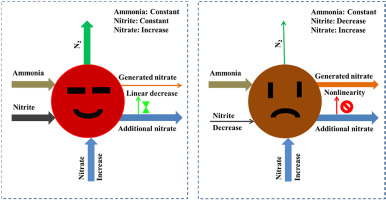当前位置:
X-MOL 学术
›
Chemosphere
›
论文详情
Our official English website, www.x-mol.net, welcomes your feedback! (Note: you will need to create a separate account there.)
Biphasic effect of nitrate on anaerobic ammonium oxidation (anammox) and related kinetic modeling.
Chemosphere ( IF 8.1 ) Pub Date : 2019-08-25 , DOI: 10.1016/j.chemosphere.2019.124654 Zhixing Li 1 , Yongzhen Peng 1
Chemosphere ( IF 8.1 ) Pub Date : 2019-08-25 , DOI: 10.1016/j.chemosphere.2019.124654 Zhixing Li 1 , Yongzhen Peng 1
Affiliation

|
Nitrate is a byproduct of the anaerobic ammonium oxidation (anammox) process and is related to its electron transfer. However, little is known about the influence of nitrate on the anammox process. In this work, the biphasic effect of exogenous nitrate on the anammox process was investigated in an upflow biofilter (UBF) reactor with ammonium as the sole electron donor. The responses of anammox to increased nitrate were analyzed by one-way ANOVA test and found to be significantly different under a constant and decreased nitrite condition (p < 0.01). With a single increase in nitrate and constant ammonium and nitrite in the influent, the total nitrogen removal rate (TNRR) of anammox was uninhibited, but stoichiometry deviated and nitrate production always showed a linear decrease. In contrast, anammox exhibited a range of activity with constant ammonium and simultaneously increased nitrate and decreased nitrite in the influent, including a continuous reduction of TNRR, a nonpersistent ammonium overconsumption and a pronounced nonlinear response of nitrate production. Correlation analysis shows that the lack of ammonium overconsumption was accompanied by the disappearance of nitrate underproduction. Kinetic models of product formation were effectively used to explore the nitrate production behavior of anammox subjected to increased nitrate, and the metabolite of nitrate was divided into a growth negative coupling type and growth (partial) coupling type under a constant and decreased nitrite condition, respectively. These findings collectively suggest that nitrate has a biphasic effect on the anammox process and is correlated with the availability of nitrite.
中文翻译:

硝酸盐对厌氧铵氧化(anammox)的双相作用和相关的动力学模型。
硝酸盐是厌氧铵氧化(厌氧氨氧化)过程的副产物,并与其电子转移有关。然而,关于硝酸盐对厌氧氨氧化过程的影响知之甚少。在这项工作中,在以铵为唯一电子供体的上流式生物滤池(UBF)反应器中,研究了外源硝酸盐对厌氧氨氧化工艺的两相作用。通过单因素方差分析分析了厌氧氨水对硝酸盐增加的响应,发现在恒定和减少的亚硝酸盐条件下,厌氧氨氮的响应显着不同(p <0.01)。随着进水中硝酸盐的单一增加以及氨和亚硝酸盐的恒定增加,厌氧氨纶的总氮去除率(TNRR)不受抑制,但化学计量偏离并且硝酸盐产量始终呈线性下降。相比之下,厌氧氨水显示出一定范围的活性,其中恒定的铵盐同时使进水中的硝酸盐增加而亚硝酸盐减少,包括TNRR的连续降低,铵盐的非持久性过度消耗以及硝酸盐生产的明显非线性响应。相关分析表明,缺乏铵过量消费伴随着硝酸盐生产不足的消失。有效地利用产物形成的动力学模型探讨了在硝酸盐增加的情况下厌氧氨水的硝酸盐生产行为,在亚硝酸盐恒定和减少的情况下,硝酸盐的代谢物分别分为生长负偶联型和生长(部分)偶联型。 。
更新日期:2019-08-26
中文翻译:

硝酸盐对厌氧铵氧化(anammox)的双相作用和相关的动力学模型。
硝酸盐是厌氧铵氧化(厌氧氨氧化)过程的副产物,并与其电子转移有关。然而,关于硝酸盐对厌氧氨氧化过程的影响知之甚少。在这项工作中,在以铵为唯一电子供体的上流式生物滤池(UBF)反应器中,研究了外源硝酸盐对厌氧氨氧化工艺的两相作用。通过单因素方差分析分析了厌氧氨水对硝酸盐增加的响应,发现在恒定和减少的亚硝酸盐条件下,厌氧氨氮的响应显着不同(p <0.01)。随着进水中硝酸盐的单一增加以及氨和亚硝酸盐的恒定增加,厌氧氨纶的总氮去除率(TNRR)不受抑制,但化学计量偏离并且硝酸盐产量始终呈线性下降。相比之下,厌氧氨水显示出一定范围的活性,其中恒定的铵盐同时使进水中的硝酸盐增加而亚硝酸盐减少,包括TNRR的连续降低,铵盐的非持久性过度消耗以及硝酸盐生产的明显非线性响应。相关分析表明,缺乏铵过量消费伴随着硝酸盐生产不足的消失。有效地利用产物形成的动力学模型探讨了在硝酸盐增加的情况下厌氧氨水的硝酸盐生产行为,在亚硝酸盐恒定和减少的情况下,硝酸盐的代谢物分别分为生长负偶联型和生长(部分)偶联型。 。










































 京公网安备 11010802027423号
京公网安备 11010802027423号